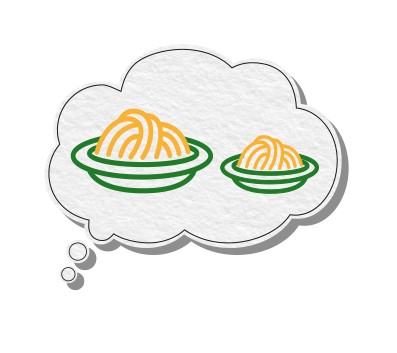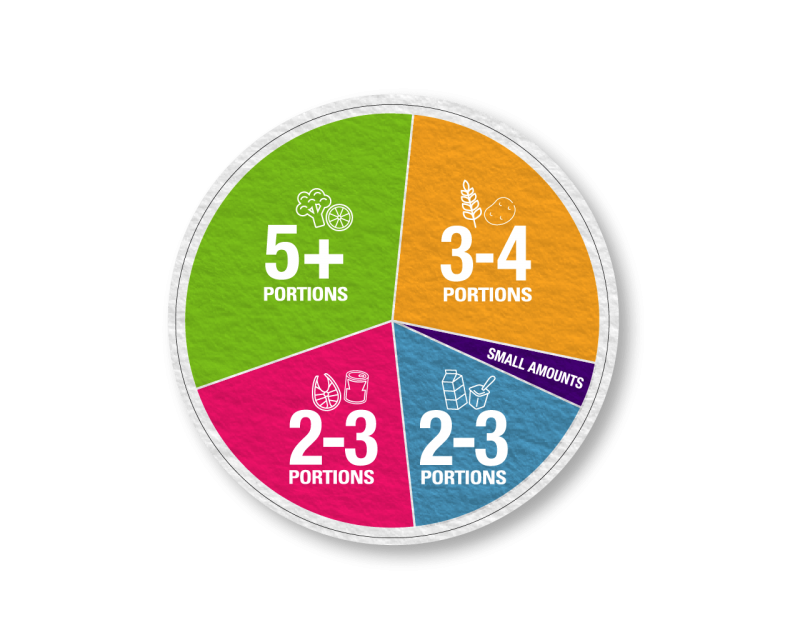Why think about portion size?

Most of us probably don’t think about portion size when we eat - it typically depends on what we would usually have, how hungry we feel and how much is in a pack or on our plate. But having a healthy, balanced diet is about getting the right types of foods and drinks in the right amounts.
Our Find your balance guide to portion size aims to help you find the right balance for you - it’s not only about eating less, its also about eating differently!
There are 3 resources you can download at the bottom of this page:
- Find your balance one page simple guide - perfect for putting on the fridge
- Find your balance booklet with example portion sizes and an example of portions for meals and snacks across a day
- Find your balance full portion list with details of portion sizes for a range of foods as well as more information and FAQs
Getting portion size right for you
We’re all individuals with different needs but for healthy adults the range of different foods we need is pretty much the same for all of us. However, the amount of food we need, varies from person to person.
The portion sizes we give are averages for healthy adults, based on a daily calorie allowance of 2000kcal - the amount estimated for an average, healthy weight, adult woman. If you’re tall or very active you may need more and could have larger portions. If you’re a small person or are trying to lose weight, you may need smaller portions. If you use the hand measures we give then portion sizes will vary with the size of your hands and so, generally, bigger people will automatically get bigger portions and smaller people will get smaller ones.
There are lots of different ways to eat a healthy diet and you can use this guidance to fit in with your preferences and beliefs – from Mediterranean, vegetarian or vegan to a more traditional British diet. It’s about balancing the food groups and finding the portion sizes that are right for you.

Finding your balance across the day
From each food group we are suggesting:
- Fruit and vegetables: 5+ portions per day
- Starchy carbohydrates: 3-4 portions per day
- Beans, pulses, fish, eggs, meat and other proteins: 2-3 portions per day
- Dairy and alternaitves: 2-3 portions per day
Portion sizes
If you really want to measure portion size accurately the best way is to weigh your food but we have provided some practical measures using your hands and spoons that you can use to get an idea of sensible portion sizes.
For example:
- 2 handfuls of dried pasta shapes or rice (75g)
- A bunch of spaghetti the size of a £1 coin, measured using your finger and thumb (75g)
- the amount of cooked pasta or rice that would fit in two hands cupped together (180g)
- A baked potato about the size of your fist (220g)
- About 3 handfuls of breakfast cereal (40g)
- A piece of grilled chicken breast about half the size of your hand (120g)
- A piece of cheddar cheese about the size of two thumbs together (30g)
- About 1 tablespoon of peanut butter (20g)
- About 3 teaspoons of soft cheese (30g)
For more details download the resources below.
We are very grateful to the members of the expert panel who helped BNF to develop these resources:
Prof Martin Wiseman, Univeristy of Southampton, Prof Marion Hetherington, Unviersity of Leeds, Dr Charlotte Evans, University of Leeds, Prof Peter Rogers, University of Bristol, Dr Laura Johnson, University of Bristol, Prof Mike Rayner, University of Oxford.
For more information about the sources used in this article please contact [email protected]
Useful links for extra material and advice:
| File | |
|---|---|
| Find your balance_ booklet.pdf | |
| Find your balance_ full portion size list.pdf | |
| Find your balance_1 page.pdf |
Article courtesy of, and copyright: British Nutrition Foundation

Comments on Find your balance - get portion wise!